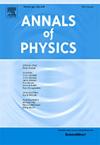关于中子星稳定性和宇宙常数的注记
IF 3
3区 物理与天体物理
Q2 PHYSICS, MULTIDISCIPLINARY
引用次数: 0
摘要
我们推导了中子星内部的压力方程,同时纳入了一个非零的宇宙常数(Λ)。然后,我们研究了Λ存在下中子星的平衡构型,并将恒星结构的稳定性定理推广到这种情况。我们的分析证实,平衡定理即使在引入宇宙常数时仍然有效。为了探索天体物理意义,我们对各种状态方程(EOS)的恒星结构方程进行了数值求解,并分析了得到的质量-半径(M-R)关系。虽然Λ的观测值对中子星性质的影响可以忽略不计,但我们发现,当Λ≥10−11m−2时,中子星的质量和半径会出现显著偏差。这一结果与前人的研究结果一致,突出了紧凑物体结构对非零Λ值的敏感性。本文章由计算机程序翻译,如有差异,请以英文原文为准。
A note on stability of neutron star and cosmological constant
We derive the equation for pressure within a neutron star while incorporating a nonzero cosmological constant (). We then examine the equilibrium configurations of neutron stars in the presence of and extend the stability theorem for stellar structures to such cases. Our analysis confirms that the equilibrium theorem remains valid even when a cosmological constant is introduced. To explore the astrophysical implications, we numerically solve the stellar structure equations for various equations of state (EOS) and analyze the resulting mass–radius (-) relations. While the observed value of has a negligible impact on neutron star properties, we find that for , significant deviations in the mass and radius of neutron stars arise. This result is consistent with previous studies, highlighting the sensitivity of compact object structure to nonzero values.
求助全文
通过发布文献求助,成功后即可免费获取论文全文。
去求助
来源期刊

Annals of Physics
物理-物理:综合
CiteScore
5.30
自引率
3.30%
发文量
211
审稿时长
47 days
期刊介绍:
Annals of Physics presents original work in all areas of basic theoretic physics research. Ideas are developed and fully explored, and thorough treatment is given to first principles and ultimate applications. Annals of Physics emphasizes clarity and intelligibility in the articles it publishes, thus making them as accessible as possible. Readers familiar with recent developments in the field are provided with sufficient detail and background to follow the arguments and understand their significance.
The Editors of the journal cover all fields of theoretical physics. Articles published in the journal are typically longer than 20 pages.
 求助内容:
求助内容: 应助结果提醒方式:
应助结果提醒方式:


